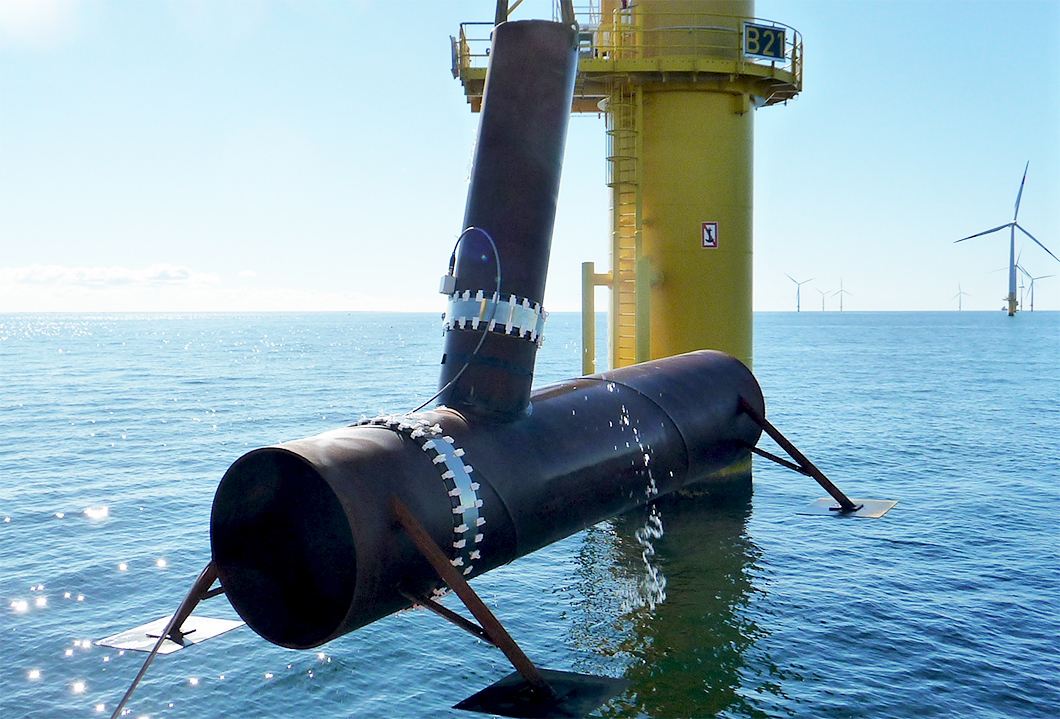
Offshore test installation of the ComoBelt for monitoring weld seams.
Source: Fraunhofer IKTS
The GW4SHM project, funded by the Marie Skłodowska-Curie Actions Innovative Training Network (H2020-MSCA-ITN-2019-860104), aims at different aspects of Structural Health Monitoring (SHM) using guided ultrasonic waves.
Project period
01/01/2020 - 21/12/2023
The aim
The overall aim of GW4SHM is to turn SHM from a lab-based technology into real-world applications. To overcome current hurdles that prevent the widespread use of SHM, GW4SHM will pursue the following three objectives:
- create efficient simulation tools to predict ultrasonic wave propagation in real-life structures made of complex materials
- develop sophisticated signal processing algorithms to interpret the measured signals, assessing the damage, and eliminating environmental and operational influences in combination with advanced transducer integration
- devise strategies to assess the reliability of SHM methods with respect to their standardisation and to utilise SHM data for condition-based maintenance and digital twins
The mission
The project will bring together partners from academia and industry and will train a new generation of researchers skilled in all aspects of SHM, enabling them to transform SHM research into practical applications. Focusing on aeronautics, petrochemistry and the automotive industry as initial pilot cases, we will develop SHM concepts to assess the integrity of structures and create ready-to-use tools for industry and other SHM users. The strong collaboration between mathematicians, physicists and engineers aims to bring the capabilities and applicability of SHM methods to the next level.
The training
Our Early Stage Researchers will acquire multidisciplinary scientific expertise, complementary skills, and experience for working in interdisciplinary teams. They will be in a prime position to take up leadership roles in academia and industry. They will enable Europe to take a leading role in the multidisciplinary area of making use of guided wave based SHM technology.
The impact
The novel methods developed within GW4SHM will pave the way for integrating SHM into real-world engineering structures, thereby improving the safety and reliability of European plants, transport systems and critical infrastructure.
Technical work packages
The GW4SHM project consists of 3 technical work packages (WP) in addition to WPs on Training and Secondment, Dissemination and Communication as well as a work package on Recruitment and Management.
Key goal of this work package is to extend the different numerical methods for simulating guide ultrasonic wave propagation and combine them according to their pros and cons to profit from the advantages offered by a combination of the various approaches. The work package aims at the development of highly efficient, easy-to-use simulation tools and numerical models for the prediction of excitation, wave propagation, and mode-flaw interaction in realistic structures for use in research and industry.
This work package aims towards the adaption and optimisation of signal processing algorithms as well as transducer concepts for SHM applications. The focus is on interpreting ultrasonic signals, to extract information about damage type, location and size, to suppress the environmental and operational influences and to utilise the information for subsequent maintenance processes in various real-life scenarios.
Key goal of this work package is to extend Probability of Detection (POD) concepts mainly by applying highly efficient simulation tools towards a framework for demonstrating the performance and reliability of SHM systems as the foundation of qualification, certification and standardisation of SHM techniques.
Funding
This project has received funding from the European Union’s Horizon 2020 research and innovation programme under the Marie Skłodowska Curie grant agreement No [860104].
